Activity-induced Ca2+ signaling in perisynaptic Schwann cells of the early postnatal mouse is mediated by P2Y1 receptors and regulates muscle fatigue
- PMID: 29384476
- PMCID: PMC5798932
- DOI: 10.7554/eLife.30839
Activity-induced Ca2+ signaling in perisynaptic Schwann cells of the early postnatal mouse is mediated by P2Y1 receptors and regulates muscle fatigue
Abstract
Perisynaptic glial cells respond to neural activity by increasing cytosolic calcium, but the significance of this pathway is unclear. Terminal/perisynaptic Schwann cells (TPSCs) are a perisynaptic glial cell at the neuromuscular junction that respond to nerve-derived substances such as acetylcholine and purines. Here, we provide genetic evidence that activity-induced calcium accumulation in neonatal TPSCs is mediated exclusively by one subtype of metabotropic purinergic receptor. In P2ry1 mutant mice lacking these responses, postsynaptic, rather than presynaptic, function was altered in response to nerve stimulation. This impairment was correlated with a greater susceptibility to activity-induced muscle fatigue. Interestingly, fatigue in P2ry1 mutants was more greatly exacerbated by exposure to high potassium than in control mice. High potassium itself increased cytosolic levels of calcium in TPSCs, a response which was also reduced P2ry1 mutants. These results suggest that activity-induced calcium responses in TPSCs regulate postsynaptic function and muscle fatigue by regulating perisynaptic potassium.
Keywords: Schwann; calcium; fatigue; mouse; neuromuscular; neuroscience; perisynaptic; potassium.
© 2018, Heredia et al.
Conflict of interest statement
DH, CF, GH, RR, TG No competing interests declared
Figures

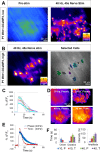

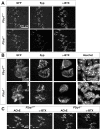

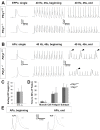
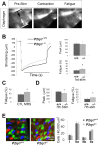
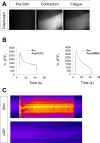
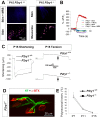
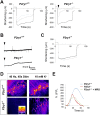




Similar articles
-
Postnatal Restriction of Activity-Induced Ca2+ Responses to Schwann Cells at the Neuromuscular Junction Are Caused by the Proximo-Distal Loss of Axonal Synaptic Vesicles during Development.J Neurosci. 2018 Oct 3;38(40):8650-8665. doi: 10.1523/JNEUROSCI.0956-18.2018. Epub 2018 Aug 24. J Neurosci. 2018. PMID: 30143570 Free PMC article.
-
Calcium Signaling in Schwann cells.Neurosci Lett. 2020 Jun 11;729:134959. doi: 10.1016/j.neulet.2020.134959. Epub 2020 Apr 25. Neurosci Lett. 2020. PMID: 32339610 Free PMC article. Review.
-
Neurally evoked calcium transients in terminal Schwann cells at the neuromuscular junction.Proc Natl Acad Sci U S A. 1992 Aug 15;89(16):7625-9. doi: 10.1073/pnas.89.16.7625. Proc Natl Acad Sci U S A. 1992. PMID: 1502174 Free PMC article.
-
Glial modulation of synaptic transmission at the neuromuscular junction.Glia. 2004 Aug 15;47(3):284-289. doi: 10.1002/glia.20086. Glia. 2004. PMID: 15252818 Review.
-
Muscarinic control of cytoskeleton in perisynaptic glia.J Neurosci. 1999 May 15;19(10):3836-46. doi: 10.1523/JNEUROSCI.19-10-03836.1999. J Neurosci. 1999. PMID: 10234016 Free PMC article.
Cited by
-
Models and methods to study Schwann cells.J Anat. 2022 Nov;241(5):1235-1258. doi: 10.1111/joa.13606. Epub 2022 Jan 5. J Anat. 2022. PMID: 34988978 Free PMC article. Review.
-
Cholinesterases in Tripartite Neuromuscular Synapse.Front Mol Neurosci. 2021 Dec 23;14:811220. doi: 10.3389/fnmol.2021.811220. eCollection 2021. Front Mol Neurosci. 2021. PMID: 35002624 Free PMC article. Review.
-
Glial cells maintain synapses by inhibiting an activity-dependent retrograde protease signal.PLoS Genet. 2019 Mar 14;15(3):e1007948. doi: 10.1371/journal.pgen.1007948. eCollection 2019 Mar. PLoS Genet. 2019. PMID: 30870413 Free PMC article.
-
Innervation: the missing link for biofabricated tissues and organs.NPJ Regen Med. 2020 Jun 5;5:11. doi: 10.1038/s41536-020-0096-1. eCollection 2020. NPJ Regen Med. 2020. PMID: 32550009 Free PMC article. Review.
-
Kir4.1 is specifically expressed and active in non-myelinating Schwann cells.Glia. 2023 Apr;71(4):926-944. doi: 10.1002/glia.24315. Epub 2022 Dec 8. Glia. 2023. PMID: 36479906 Free PMC article.
References
-
- Adler M, Sweeney RE, Hamilton TA, Lockridge O, Duysen EG, Purcell AL, Deshpande SS. Role of acetylcholinesterase on the structure and function of cholinergic synapses: insights gained from studies on knockout mice. Cellular and Molecular Neurobiology. 2011;31:909–920. doi: 10.1007/s10571-011-9690-5. - DOI - PMC - PubMed
-
- Akerboom J, Carreras Calderón N, Tian L, Wabnig S, Prigge M, Tolö J, Gordus A, Orger MB, Severi KE, Macklin JJ, Patel R, Pulver SR, Wardill TJ, Fischer E, Schüler C, Chen TW, Sarkisyan KS, Marvin JS, Bargmann CI, Kim DS, Kügler S, Lagnado L, Hegemann P, Gottschalk A, Schreiter ER, Looger LL. Genetically encoded calcium indicators for multi-color neural activity imaging and combination with optogenetics. Frontiers in Molecular Neuroscience. 2013;6:2. doi: 10.3389/fnmol.2013.00002. - DOI - PMC - PubMed
Publication types
MeSH terms
Substances
Grants and funding
LinkOut - more resources
Full Text Sources
Other Literature Sources
Molecular Biology Databases
Miscellaneous

